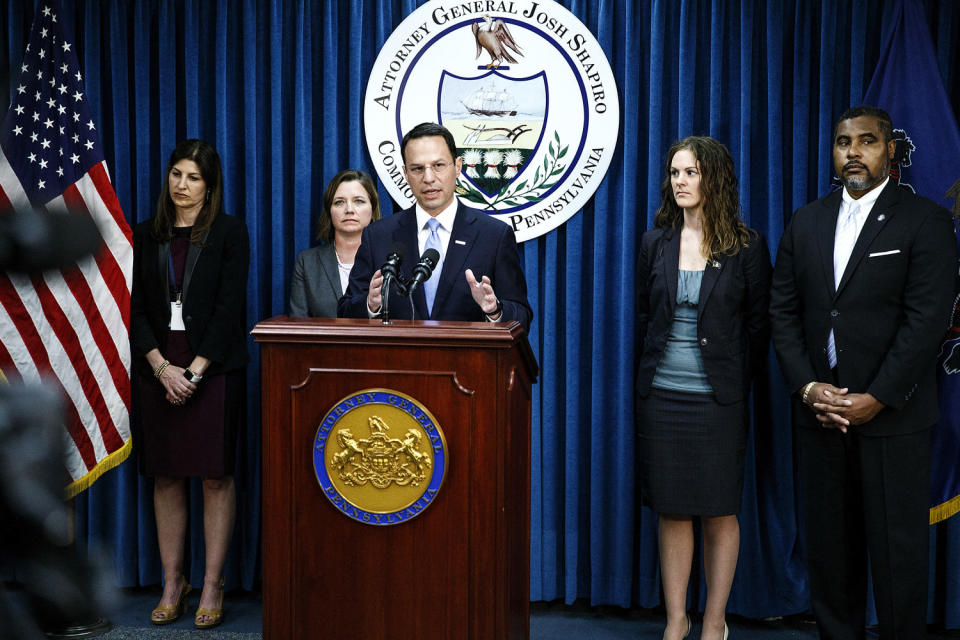The top contenders to be Kamala Harris’ running mate got to this point, in part, by battling Donald Trump.
Five of the six vice presidential prospects who have met with Harris’ team in recent days cultivated their state and national profiles by being prominent figures in the MAGA “resistance” — whether it was clashing with Trump as governor or state prosecutor, defeating his protégés in important races or pitching a new kind of politics in response to his rise.
Presidents don’t usually end up in direct confrontation with the politicians who rise as their counterweights during a first term. But Trump has now been on the scene long enough that those who rose in backlash against his first term are rising still further into national politics.
Now, one of them is likely to become the vice presidential nominee on the Democratic ticket aiming to thwart his comeback bid.
Some Democrats say their familiarity with Trump will be an asset to Harris.
“Trumpism has lost every election for almost a decade. Having to run against the very people who have beaten his crew time and again must be driving him to melt down even further,” said Jesse Ferguson, a Democratic strategist who worked on Hillary Clinton’s 2016 campaign, which narrowly lost to Trump. “These people know how to contrast their common sense with the extreme weirdness of MAGA and Trump. They’ve proven it.”
The Trump campaign said it isn’t worried.
“Our hearts go out to whomever Kamala Harris chooses as her running mate, as they will be asked every day for the next 95 days how they could possibly stand by the most weak, failed, and dangerously liberal candidate in history,” Trump campaign spokeswoman Karoline Leavitt said in an email. “And we will be more than prepared to hold them accountable for their own record as well.”
Pennsylvania Gov. Josh Shapiro started building his national profile as state attorney general when he brought suits against the Trump administration on issues including its attempt to reverse the contraception coverage requirement for health insurance and the travel ban against people from majority-Muslim countries. He also fought Trump’s attempt to stay in power after losing the 2020 election.

In 2022, Shapiro ran for governor against a Trump-endorsed MAGA die-hard, state Sen. Doug Mastriano, and trounced him by nearly 15 points, an eye-catching margin in a closely divided state that raised his stock in the political arena. Mastriano, who was subpoenaed by the Jan. 6 committee and organized buses to Washington on Jan. 6, 2021, was present on the restricted grounds of the U.S. Capitol that day, entering an area on the east side of the Capitol after other Trump supporters broke through barricades, though Mastriano said he followed police lines “as they existed” and left when it was clear it wasn’t peaceful.
Meanwhile, Sen. Mark Kelly, D-Ariz., a former astronaut and Navy pilot, was first elected in a 2020 special election, which was largely a referendum on Trump. Kelly and President Joe Biden painted Arizona blue in a presidential election for the first time since 1996.
Two years later, Kelly ran again for a full six-year term and defeated Trump-endorsed Republican Blake Masters, disparaging Masters as a “dangerous” election denier and highlighting other unpopular Trump-aligned positions.
Minnesota Gov. Tim Walz got his start in elected office running alongside backlash to a different Republican president, winning a seat in Congress in 2006. He held his red-trending House seat by less than 1 point in 2016, when Trump dominated the district by double digits. Two years later, he rode a blue wave of anti-Trump sentiment to become governor of the state.
More recently, he has gone viral by belittling Trump and his MAGA movement as “weird.”
Transportation Secretary Pete Buttigieg had in some ways the sharpest Trump-era rise in 2019, when he sought to make the unlikely jump from small-city mayor of South Bend, Indiana, to the White House. He ran for president pitching generational change and a new kind of politics at a time when Democratic angst with Trump was at a fever pitch.


It caught on, to a degree: Buttigieg rocketed from obscurity to narrowly win the 2020 Iowa caucuses and come in second in New Hampshire’s Democratic primary. He fell short in the later primaries, dropped out and endorsed Biden — before becoming his transportation secretary.
Illinois Gov. JB Pritzker may be the most outspoken Trump critic of the pack, often insulting the ex-president as a “racist,” a “homophobe,” a “misogynist” and a felon. He has also belittled Trump as “just a flatulent old man with an orange spray-tan who fell asleep at his own trial.” He too won his office in 2018, when the combination of a backlash midterm against Trump and Illinois’ blue hue was too much for then-Gov. Bruce Rauner, the Republican incumbent.
Then there’s Kentucky Gov. Andy Beshear, who is also in the mix for Harris’ running mate position. His rise in deep-red Kentucky is less tied to Trump, and a big part of his appeal as a potential vice president is his ability to win Trump voters.
But Beshear did defeat a Trump-like GOP opponent in 2019 and used the backlash to the end of Roe v. Wade to comfortably win a second term as governor in 2023.
One way or another, Trump played a big role creating the cast of characters that could complete the Democratic ticket he’s facing this year.
This article was originally published on NBCNews.com


